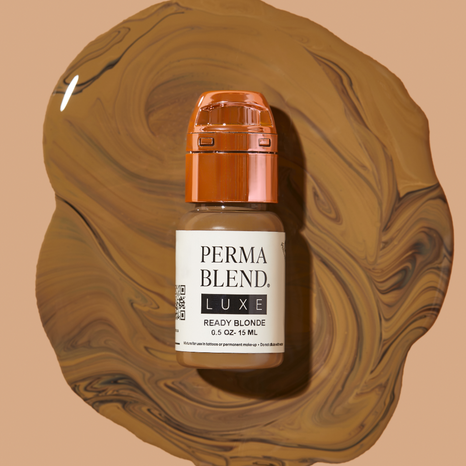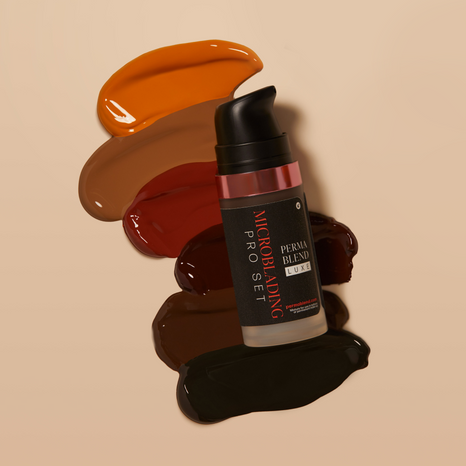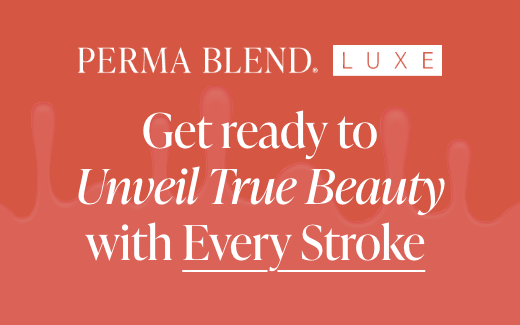Microblading: Transitioning from Blade to Machine
A closer look at each style to shape your preference.

Article Summary
- Microblading vs. Machine Work: Choosing Brow Techniques
+ Traditional microblading creates natural hair strokes by slicing into the skin. It is best for dry skin, yet fades quicker.
+ Machine work creates bold brows by depositing a single needle into the skin with powder-like strokes. Suits oily or sensitive skin, and is longer-lasting. - Combining Techniques for Brow Perfection
+ Blend microblading and machine work for versatility.
+ Achieve a natural "ombre" look or enhance microbladed brows. - Transitioning Tips
+ Use the same inks for both techniques but adjust thickness.
+ Perma Blend offers versatile inks; the choice depends on the artist's skills and client preference. - Perma Blend: Your Brow Perfection Partner
+ Perma Blend provides the tools for stunning, long-lasting brows.
Microblading: Transitioning from Blade to Machine
If you are a PMU artist, you know that there isn’t just ONE technique for creating beautiful brows. One of the most popular techniques that most people learn is microblading.
Microblading, as you probably know, uses a thin blade(s) to make hair-like strokes in the brows. This method has been around for a very long time, but there is another method that has equal popularity and can provide PMU artists some much-needed flexibility with their clients.
“Machine work” keeps the ultimate goal of creating beautiful brows unchanged. Machines use a needle to make tiny dots, as opposed to the straight lines created manually with a blade.
There are plenty of differences and similarities between the two methods, but how can you choose the best one for your clients? Today, we are going to look at how to incorporate (and possibly transition) to machine work for your practice, plus a whole lot of other useful tips.

Right pigments for the right process. LUXE Ready Set Go, READY BLONDE

Machines designed for applying permanent makeup by using a single needle to create a "powder" effect usually call for inks with varying viscosity, like LUXE Ready Set Go, on the left, notably looser in texture than microblading inks.

The plot thickens... Perma Blend LUXE Microblading Pro Set

As seen above, the thicker viscosity, or texture, of microblading ink allows for seamless strokes to deposit into the skin. The specific formulations in microblading inks, like Perma Blend LUXE Microblading Pro Set on the left, helps with the retention on the blade for the manual process.
From Microblading to Machine
To be clear, we at Perma Blend aren’t in the business of pitting these two styles against one another. Still, there are certain advantages and disadvantages to both, and it’s worth knowing what those are. Also, there are a lot of really fascinating techniques that use a combination of BOTH to achieve truly fantastic results.
Microblading is ideal for clients who want natural-looking brows that enhance their facial features. It can also help improve symmetry, shape, and hair density. Microblading works best on normal to dry skin types, since microblading is nearly impossible for oily skin types or very mature skin. 
Hot Tip: For machine work (typically referred to as nano brows), and their methods, they're beautiful options for ANY service; Perma Blend inks are well-suited for creating gradient effects and soft transitions of color, from subtle shading to bold and defined looks, like our award-winning, pre-modified LUXE Ready Set Go Set.Opens a new window

Hot Tip: For manual work like microblading, inks designed for microblading can come in handy. The thickness of the inks helps with needle retention, meaning the blades are able to hold the pigments longer for application to minimize excess and constant dipping. As shown with the inks from our Microblading Pro Set above, the textures are thicker, highly pigmented and opaque.
However, microblading also has some drawbacks. Since the process calls for slicing into the skin, if not done properly. your client can be at risk for infection. There are also other drawbacks such as quicker fading, meaning a quicker turn-around for more touch-ups, Although not true for everyone, some clients report it’s less painful, probably because it does not penetrate as deep into the skin.
Machine work is another technique for creating permanent brows, but it uses an electric device with a needle that makes tiny dots in the skin. The dots can create a powder or hair stroke effect that looks like regular makeup. The pigment lasts longer than microblading, as it goes further into the skin. Machine work can also create different styles of brows, such as ombre or combination.
Machine work has the ability to give the client a bolder brow that stands out. It can also work well on oily or sensitive skin types since it’s less traumatic and irritating. Machine work also requires fewer touch-ups than microblading and doesn’t usually fade as fast.
Microblading + Machine Work (It’s Not a Competition)

As a PMU artist, both these methods have their perks, and you can use both techniques to create stunning eyebrows that suit your clients’ styles and goals.
By combining microblading and machine work, you can achieve more versatility, creativity, and customization in your work.
For example, you can use microblading to create hair strokes in the front of the brow or

throughout the brow and machine work to create shading or powder effect in the rest of the brows. This can create a more natural and balanced look that transitions from light to dark (famously known as “ombre”).
You can also use machine work to add some shading or depth to your microbladed brows, especially if they are sparse or have gaps. This can create a more defined and fuller look that lasts longer.
Using Microblading Inks
If you are a PMU artist who started with microblading and want to transition to machine work, you might wonder if you can use the same inks for both techniques. The answer is yes. But microblading ink is quite a bit thicker than machine inks and that needs to be accounted for. Simply dilute microblading inks with a shading solution if you want to create a softer or lighter effect by putting shading solution in the microblading product.
Perma Blend has microblading inks that are suitable for microblading and machine work, as they are highly concentrated, stable, and long-lasting.
Ultimately, whichever technique and style you go for, Perma Blend has the tools to make it happen!
Opens a new windowCan I get a combo? Brilliant Pro Artist and brow guru Natalie Della-Verde creates spectacular combination brows by using the Microblading Pro Set's All Night Long and Spill the Tea in varying fashion. A microblading needle is used to create simple strokes in front of the brow. Then, after applying shading solution, she switches to Perma Pen SignatureOpens a new window to shade the center of her client's eyebrow.
Hot Tip: Applying shading solution will dilute the pigment load of the ink, changing the strength of saturation. In truth, it’s about the artists knowledge plus the client desires that’s going to give artists the best outcome for their client’s brows.
Beauty that won't wash awayPerma Blend is the color expert in permanent cosmetics. We empower professional beauty artists to create true transformations for their clients. Featuring an extensive palette of over 200 vegan pigments for timeless beauty, from 'no-makeup' makeup to bold, iconic looks with our award-winning color range for all skin tones.
No more hassle. Just hustle.
You May Also Like...

